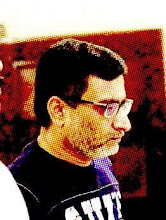Here is a summary of a mini talk presented at Chennai Weekend Artists gathering at Chemmozhi Poonga.
This introductory discussion explored the use of Gesture and Thumbnail as essential tools for Sketching. The ideas are largely based on the great art instructors Kimon Nicholaides and Glenn Vilppu, among others.
Gesture
 |
| Thanks Balaji for the image. |
Gesture
When we begin drawing, we begin to look at the subject in 'total'. and try to capture the very essential, by ignoring elements such as form, proportions, anatomical details, etc.
Using a scribbling approach , beginning at whichever part of the subject one wants to, the overall appearance, or 'feel' of the subject is captured.
The 'method' is to look at the subject and 'feel' like the subject. feel the tension, twist and turn of the subject, in yourself, and let the pen scribble its way.
Remember, what we are trying to capture is the 'total'. and the 'feel'.
Some examples..
What this does is, it helps us see only the bare essential. One should keep practicing this from observation. This not only loosens up the hand, but aids us see just enough so that we can re create it at will later.
This approach is an essential part of drawing by analysis and synthesis. (as opposed to 'copying' the model)
Some examples from imagination...
Eventually we will include subsequent steps that will take us from point A to point B in a systematic and natural manner.
Thumbnail
When we begin to sketch on location, here is a general approach.
(1) Identify your frame
- First step is to Identify a subject, or view of interest.
- Fine tune the view by visualizing the frame. If needed using a view finder. (Make a simple view finder)
Now draw a few thumbnails each should not take you more than 10-25 seconds.
(2) Thumbnail
- Draw 3-4 gestural lines exploring the frame.
- Identify major forms, 3-4 maximum.
- Identify the tones, using 2 tones and the white of the paper.
Here is an example (Let me add that step (1) is already taken care of well in these examples through the eyes and lens of Murali)
Another example..
These simple preliminary steps aid in a better picture subsequently. Next steps include how we organize the space into foreground, middle ground and background, and how we use techniques such as linear and atmospheric perspective as well as textures to define the three planes, etc.
Equipped with this simple yet effective tools, we can create more effective sketches, in an enjoyable manner.










